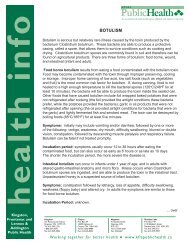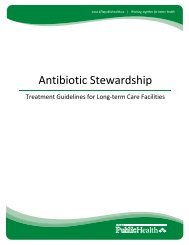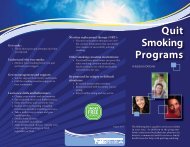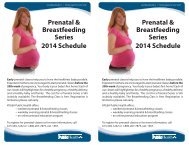Food Allergies and Anaphylaxis - KFL&A Public Health
Food Allergies and Anaphylaxis - KFL&A Public Health
Food Allergies and Anaphylaxis - KFL&A Public Health
Create successful ePaper yourself
Turn your PDF publications into a flip-book with our unique Google optimized e-Paper software.
How can we prevent an allergic reaction?<br />
When Shopping:<br />
Read the ingredient list every time you shop.<br />
Ingredients often change without warning—a<br />
product that was safe last week may not be safe<br />
this week.<br />
Be aware of the words on the ingredient list that<br />
may indicate the presence of an allergen.<br />
Avoid foods with the disclaimer “may contain<br />
traces of allergen (e.g. peanuts).” There is no<br />
guarantee that these foods are safe for the<br />
food-allergic person.<br />
Avoid foods without a complete ingredient list,<br />
such as bulk foods or on-site bakery items.<br />
Choose less processed foods. Generally, the<br />
less processed a food, the easier it is to identify its<br />
ingredients.<br />
Avoid imported food with foreign language<br />
ingredient lists <strong>and</strong> those foods that do not follow<br />
the Canadian <strong>Food</strong> Inspection Agency guidelines.<br />
If you do not know what an ingredient word<br />
means, do not buy the food.<br />
Have a pad <strong>and</strong> pen with you when you shop. If<br />
you have a question about a product, record the<br />
manufacturer’s name, phone number, <strong>and</strong> address.<br />
Contact the manufacturer when you get home.<br />
State that you have a food allergy <strong>and</strong> ask whether<br />
the product contains a particular allergen.<br />
Most allergic reactions are due to cross<br />
contamination. “Safe” foods become “unsafe”<br />
through contact with allergen particles. For<br />
example, the same knife from the peanut<br />
butter jar is put into the jam jar. The jam is<br />
now unsafe for people with a peanut allergy.<br />
Or, the same cutting board is used the make<br />
both an egg-salad s<strong>and</strong>wich <strong>and</strong> a turkey<br />
s<strong>and</strong>wich without being washed in between.<br />
The turkey s<strong>and</strong>wich is now unsafe for people<br />
with an egg allergy.<br />
How can we prevent an allergic reaction?<br />
When preparing foods:<br />
Use soap <strong>and</strong> water to clean h<strong>and</strong>s before <strong>and</strong><br />
after eating. H<strong>and</strong> sanitizers are not suitable, as<br />
they may not rid traces of an allergen.<br />
Wash all utensils, counters, <strong>and</strong> eating surfaces<br />
with a household cleaner before <strong>and</strong> after food<br />
preparation. This will help to avoid “cross<br />
contamination.”

















